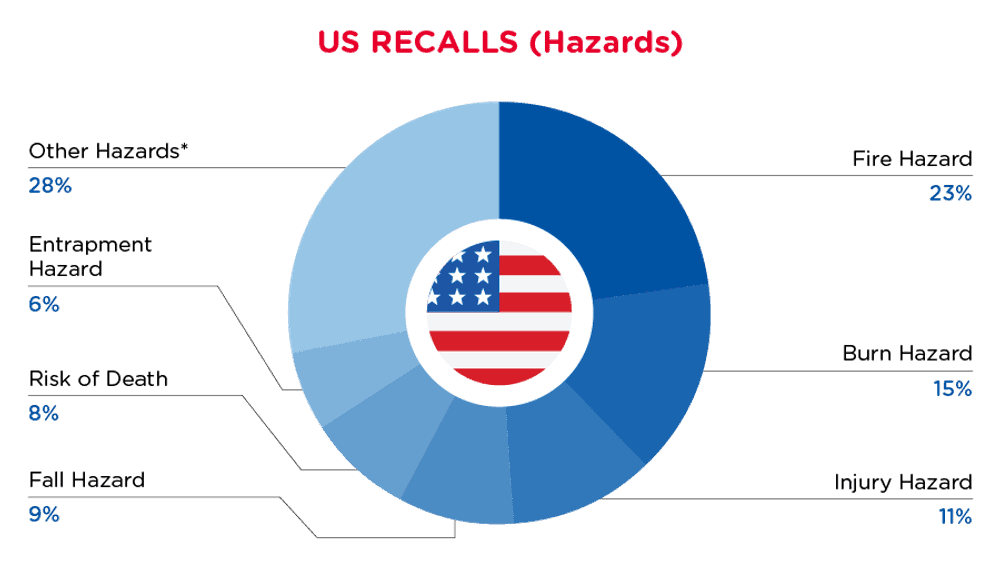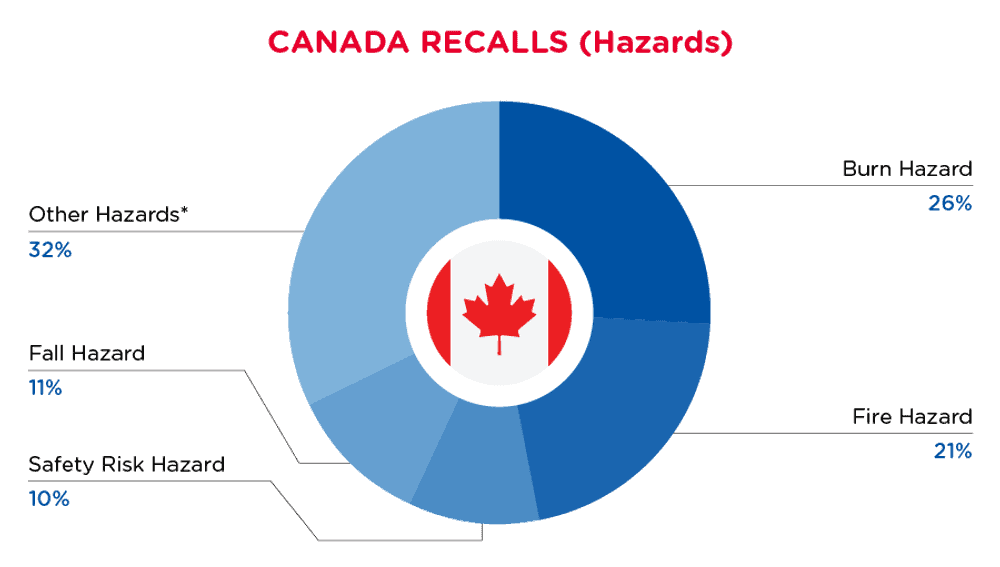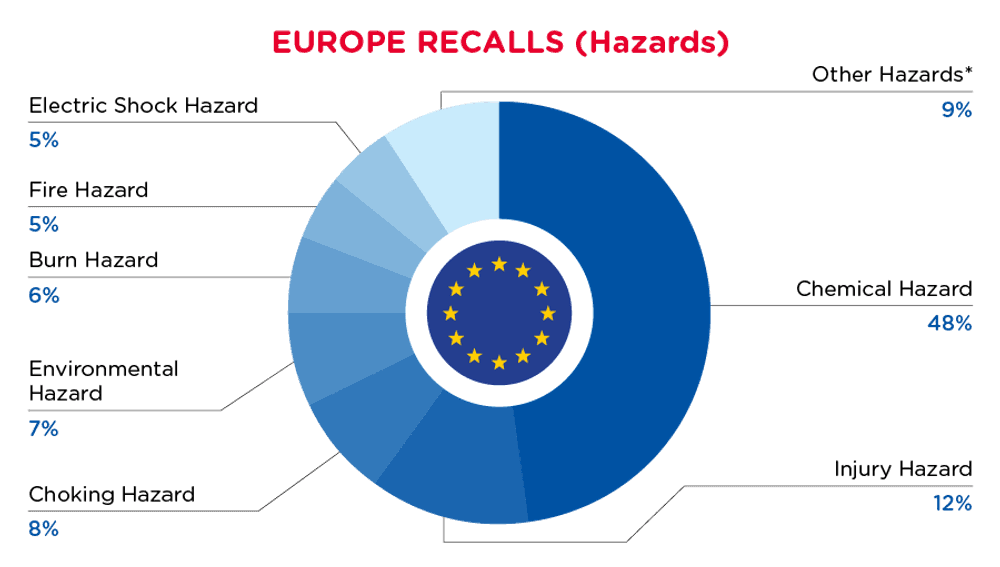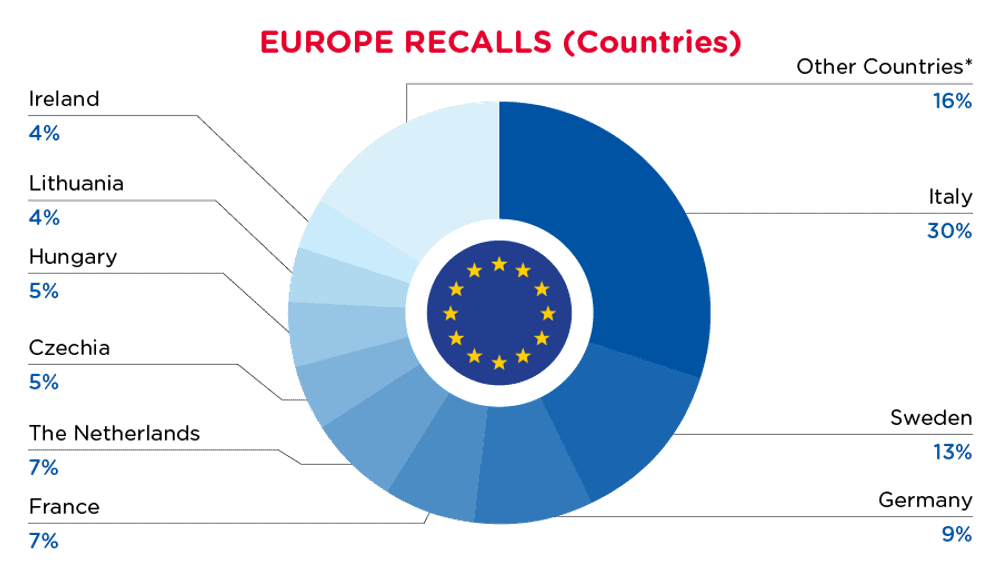julho 2024
Notícias da América do Norte
Em junho de 2012, a Comissão de Segurança de Produtos de Consumo dos EUA (CPSC) publicou um padrão de segurança de produtos de consumo para balanços de bebês de acordo com a seção 104 da Lei de Melhoria da Segurança de Produtos de Consumo de 2008 (CPSIA). A norma incorporada por referência foi atualizada para fazer referência à ASTM F2088-24, Standard Consumer Safety Specification for Infant and Cradle Swings (Especificação padrão de segurança do consumidor para balanços de berço e para bebês). A regra entrará em vigor em 14 de setembro de 2024, a menos que a Comissão receba um comentário adverso significativo até 1º de julho de 2024.
A ASTM emitiu uma norma revisada, a ASTM F2088-24, Standard Consumer Safety Specification for Infant and Cradle Swings (Especificação padrão de segurança do consumidor para balanços de berço e para bebês). Em conformidade com o processo de atualização da CPSIA, essa regra final direta atualiza a norma obrigatória, 16 CFR 1223, para incorporar por referência a versão 2024 da norma voluntária da ASTM. Ela também revisa a norma obrigatória para incluir "balanços de berço" para alinhar-se com a norma voluntária.
Contém alterações substanciais nos requisitos da seção 6.9 que abordam o risco de estrangulamento e aprisionamento de não ocupantes associado a cintas e cordas amarradas em balanços
Aborda o perigo de aprisionamento e estrangulamento da cabeça. Os requisitos revisados e os métodos de teste correspondentes garantem que todas as aberturas delimitadas pela cinta sejam muito pequenas para que a cabeça do bebê entre ou sejam grandes o suficiente para que a cabeça do bebê escape.
Inclui disposições revisadas na seção Requisitos de desempenho (seção 6.9) e na seção Métodos de teste (seção 7.16).
Adiciona o uso de uma ferramenta de superfície de fixação de 3/4 de polegada de diâmetro durante o método de teste de avaliação de cinta/corda para garantir a consistência durante a aplicação da força de tração.
Especifica, durante a avaliação das aberturas delimitadas, as forças de inserção a serem usadas com as sondas de cabeça pequena e grande. As forças de inserção permitem a compressão de produtos macios na área de teste e a consistência do teste.
Inclui uma disposição nos métodos de teste para usar uma sonda cilíndrica com circunferência de 7,4 polegadas para avaliar o comprimento e a tensão da cinta/corda após o teste da sonda de cabeça grande na avaliação da abertura limitada
Inclui novas figuras para fornecer dimensões e ilustrações de algumas sondas
Inclui várias adições e revisões menores que são editoriais e não alteram nenhum requisito substantivo da norma.
A regra entrará em vigor em 14 de setembro de 2024, a menos que a Comissão receba um comentário adverso significativo até 1º de julho de 2024.
Link de referência:
https://www.govinfo.gov/content/pkg/FR-2024-05-30/pdf/2024-11792.pdf
New Regulations have been enacted specific to the prohibition of mercury-containing lighting products in the state of Minnesota.
To protect the environment and public health, Minnesota has enacted a new law prohibiting the sale and distribution of mercury-containing general-purpose lighting products. The regulations are as follows:
Effective Dates:
Starting 1 January 2025: The sale, offering for sale, or distribution of newly manufactured screw- or bayonet-base compact fluorescent lamps (CFLs), mercury vapor lamps, and mercury vapor lamp ballasts is prohibited.
Starting 1 January 2026: The sale, offering for sale, or distribution of newly manufactured pin-base compact fluorescent lamps or linear fluorescent lamps is prohibited.
Exemptions:
The following lighting products are exempt from this prohibition:
Lamps designed and marketed exclusively for image capture and projection (e.g., photocopying, printing, film projection).
Lamps emitting a high proportion of ultraviolet light used for germicidal purposes, disinfection, fly-trapping, ozone generation, coral zooxanthellae symbiosis, or sunlamp products.
Specialty application mercury vapor lamp ballasts.
Compact fluorescent lamps used to replace lamps in motor vehicles manufactured on or before January 1 2020.
Additional Provisions:
Nothing in this section limits the ability of a utility to offer energy-efficient lighting, rebates, or lamp-recycling services or to claim energy savings resulting from such programs through the utility's energy conservation and optimization plans approved by the commissioner of commerce under section 216B.241 or an energy conservation and optimization plan filed by a consumer-owned utility under section 216B.2403.
Reference Link:
Health Canada has made changes to the Cosmetic Ingredient Hotlist in May 2024.
In May 2024, Health Canada updated the Cosmetic Ingredient Hotlist. The Cosmetic Ingredient Hotlist is an administrative tool used by Health Canada to communicate to manufacturers and others that certain substances may be prohibited or restricted for use in cosmetics.
The changes include the below:
Items added: Basic green 4, Benzophenone, p-Chloro-m-cresol & Solvent violet 13
Items Amended:
Dialkanolamines, secondary - entry amended to include secondary alkyl- and alkanolamines and their salts for clarity.
Alpha-hydroxy acids - entry amended to clarify that Polyhydroxy acids (PHAs) and bionic acids with alpha-hydroxyl groups are included, and the maximum permitted concentration for consumer use category was increased from 10% to 18%.
Hydroquinone - entry amended to expand the permitted nail product categories and increase the maximum concentration permitted.
p-Hydroxyanisole - entry amended to introduce a combined limit when both p-hydroxyanisole and hydroquinone are used in a nail product.
Talc - entry amended to help reduce chronic inhalation and genital exposure.
Manufacturers and importers should take note of these updates.
In the US, when hazards are identified in consumer products, they will be recalled and published in the Consumer Product Safety Commission (CPSC) Recent Recalls on the CPSC website, which is updated daily. The US recalls from 01 June 2024 to 30 June 2024 are summarized below:

| Hazards | Frequency |
| Fire Hazard | 12 |
| Burn Hazard | 8 |
| Injury Hazard | 6 |
| Fall Hazard | 5 |
| Risk of Death | 4 |
| Entrapment Hazard | 3 |
| Other Hazards* | 15 |
*Other Hazards include Laceration Hazard, Tip-Over Hazard, Crushing Hazard, Crash Hazard, Swallowing Risk, Safety Risk Hazard, Microbiological Hazard, Skin Irritation Risk Suffocation Hazard, Chemical Hazard, Electric Shock Hazard, Amputation Hazard and Eye Irritation Risk with a frequency of less than 3.

| Product Categories | Frequency |
| Electrical Appliances | 8 |
| Toys and Childcare Products | 5 |
| Sporting Goods / Equipment | 5 |
| Furniture | 3 |
| Household Items | 2 |
| Home Electrical Appliances | 2 |
| Other Categories* | 5 |
*Other Categories include Tools and Hardware, Pet Items, Machinery, Fabric / Textile / Garment / Home Textile and Food Contact Material with a frequency of less than 2.
For a complete list click here
In Canada, when hazards are identified in consumer products, they will be recalled and published in the Recalls and Safety Alerts Database on the Health Canada website, which is updated daily. The Canada recalls from 01 June 2024 to 30 June 2024 are summarized below:

| Hazards | Frequency |
| Burn Hazard | 5 |
| Fire Hazard | 4 |
| Safety Risk Hazard | 2 |
| Fall Hazard | 2 |
| Other Hazards* | 6 |
*Other Hazards include Microbiological Hazard, Skin Irritation Risk, Laceration Hazard, Suffocation Hazard, Eye Irritation Risk and Entrapment Hazard with a frequency of less than 2.

| Product Categories | Frequency |
| Electrical Appliances | 4 |
| Toys and Childcare Products | 2 |
| Sporting Goods / Equipment | 2 |
| Tools and Hardware | 1 |
| Fabric / Textile / Garment / Home Textile | 1 |
| Pet Items | 1 |
| Machinery | 1 |
| Home Electrical Appliances | 1 |
For a complete list click here
Notícias da Europa
On 01 July 2024, the European Commission issued the first update to the Rolling List of (groups of) Substances for Restriction, which is appended to the European Restrictions Roadmap published in April 2022. This update provides information on substances that are being considered for potential restriction under the REACH regulation.
The updated Rolling List of substances for restriction was updated on 01 July 2024.
This roadmap describes ongoing efforts and coming plans for restrictions under the European Union (EU) Registration, Evaluation, Authorisation and Restriction of Chemicals (REACH) regulation.
The Rolling List is divided into two pools as below.
Pool 0 Substances already included in the Registry of Intention (RoI) for restrictions or where the Commission has requested the European Chemicals Agency (ECHA) to prepare a restriction dossier.
Pool 1 Substances for which work is advanced and are under consideration by ECHA, Member States, or the Commission for restriction. For “Pool 0”, the recent updates are summarized as below.
| Subject | Hazards | Uses | State of Play |
| Carcinogenic, Mutagenic, and Reprotoxic (CMRs) in childcare articles | CMR | Articles | ECHA investigation report submitted; REACH committee discussion planned for October 2024 |
| Chromium VI compounds | CMR | Industrial, Professional | RoI entry added October 2023; Annex XV dossier submission planned for 4 April 2024 |
| 1,4-dioxane | Carcinogenic, Persistent, mobile and toxic (PMT-like) | Industrial, Professional, Consumer | RoI entry updated October 2023; Annex XV submission planned for October 2025 |
| Octocrilene | Aquatic toxicity | Specific uses in plastisol and cosmetics | RoI entry added October 2023; Annex XV dossier submission planned for 10 January 2025 |
And highlights for “Pool 1” are shown as below:
Polyvinyl Chloride (PVC) and its additives: Possible mandate to ECHA for restriction dossier preparation, anticipated RoI inclusion in Q3 2024.
Flame retardants: Investigation report due December 2024; potential restriction dossier decision in Q4 2024/Q1 2025.
Ortho-phthalates (C4-C6): Possible restriction via Article 69(1), not anticipated before Q4 2025.
Bisphenols: Assessment ongoing for further regulatory action, including restrictions, Substances of Very High Concern (SVHC) identification, or Harmonised, Classification, Labelling (CLH).
Hydrocarbyl siloxanes: Potential restriction based on Bio-accumulative and Toxic (PBT) or very Persistent and very Bio-accumulative (vPvB) properties, not anticipated before 2025.
The update also includes information on restriction cases under opinion making, decision making, or recently decided.
This update reflects the EU's ongoing efforts to manage chemical risks and implement the Chemicals Strategy for Sustainability. Stakeholders should monitor these developments closely as they may impact various industries and product categories.
In Europe, when hazards are identified in non-food consumer products, the products will be recalled and published in the Safety Gate system, which is updated weekly. The European recalls from 01 June 2024 to 30 June 2024 are summarized below:

| Hazards | Frequency |
| Chemical Hazard | 124 |
| Injury Hazard | 31 |
| Choking Hazard | 22 |
| Environmental Hazard | 17 |
| Burn Hazard | 15 |
| Fire Hazard | 12 |
| Electric Shock Hazard | 12 |
| Other Hazards* | 22 |
*Other Hazards include Damage to Hearing, Strangulation Hazard, Suffocation Hazard, Drowning Hazard, Health Risk Hazard and Cut Hazard with a frequency of less than 12.

| Product Categories | Frequency |
| Bodycare / Cosmetics | 80 |
| Toys and Childcare Products | 36 |
| Electrical Appliances | 28 |
| Jewelry | 19 |
| Outdoor Living Items | 12 |
| Fabric / Textile / Garment / Home Textile | 10 |
| Chemicals | 6 |
| Other Categories* | 20 |
*Other Categories include Sporting Goods / Equipment, Computer / Audio / Video / Other Electronics & Accessories, Accessories, Stationery, Machinery, Food Contact Material, Footwear, Protective Equipment and Home Electrical Appliances with a frequency of less than 6.

| Notifying Country | Frequency |
| Italy | 63 |
| Sweden | 27 |
| Germany | 19 |
| France | 16 |
| The Netherlands | 14 |
| Czechia | 11 |
| Hungary | 11 |
| Lithuania | 8 |
| Ireland | 8 |
| Other Countries* | 34 |
*Other Countries include Slovakia, Denmark, Poland, Finland, Romania, Bulgaria, Spain, Malta, Belgium and Austria with a frequency of less than 8.
For a complete list click here
Notícias da Ásia
Em 10 de julho de 2024, a Ordem do Gabinete nº 244, para incluir isômeros de PFOA ou seus sais e compostos relacionados ao PFOA como Substâncias Químicas Especificadas de Classe I, foi publicada no Jornal Oficial do Japão, como uma alteração da Ordem do Gabinete nº 202 de 1974. Exceto pelo período de transição descrito para o 8:2 FTOH e o PFOI, essa alteração entrará em vigor em 10 de janeiro de 2025.
O Japão expandiu seu escopo sobre o Gerenciamento de Produtos Químicos em Substâncias Químicas Especificadas de Classe I, emitindo a Ordem do Gabinete nº 244, que altera a Ordem do Gabinete nº 202 de 1974. Esse é um esforço contínuo para abordar os "produtos químicos eternos" que foram determinados como carcinogênicos para os seres humanos. Os principais conteúdos do Cabinet Order No. 244 são:
Expansão do escopo das substâncias relacionadas ao PFOA; veja a tabela comparativa dos PFAS listados nas Substâncias Especificadas de Classe I(Tabela 1 abaixo, com conteúdo atualizado em vermelho):
Tabela 1
| Anterior | Atualizada | ||
| Entrada 17 | PFOS ou seus sais | Entrada 17 | PFOS ou seus sais |
| Entrada 18 | PFOSF | Entrada 18 | PFOSF |
| Entrada 34 | PFOA ou seus sais | Entrada 34 | PFOA ou seus isômeros, ou seus sais |
| Entrada 35 | PFHxS ou seus isômeros ((limitado a estruturas ramificadas com 6 átomos de carbono)) ou seus sais | Entrada 35 | Compostos relacionados ao PFOA (iodeto de perfluorooctilo (PFOI), álcool fluorotelômero 8:2 (8:2 FTOH) e substâncias que se degradam em PFOA) |
| / | / | Entrada 36 | PFHxS ou seus isômeros (limitados a estruturas ramificadas com 6 átomos de carbono) ou seus sais |
2. Proibição de produtos importados que contenham compostos relacionados ao PFOA (consulte a Tabela 2 abaixo)
Tabela 2
| Substância | Produto/escopo | Requisito | Eficaz Data |
| Compostos relacionados ao PFOA (exceto 8:2 FTOH e PFOI) | Agentes antiespumantes Roupas tratadas com propriedades repelentes de óleo ou água Tecidos tratados com propriedades repelentes de óleo ou água Extintores de incêndio, agentes extintores de incêndio para extintores de incêndio e espumas extintoras de incêndio Revestimentos de piso tratados com propriedades repelentes de óleo ou água Cera para pisos Agentes repelentes de óleo, repelentes de água e anti-incrustantes e agentes de proteção de fibras Fibras ópticas ou agentes de revestimento aplicados a fibras ópticas | Proibido | 10 de janeiro 2025 |
| 8:2 FTOH | Dispositivos médicos invasivos e implantáveis | Proibido | 3 de dezembro de 2025 |
| PFOI | Fabricação de brometo de perfluorooctilo (PFOB) para produtos farmacêuticos | Proibido | 31 de dezembro de 2036 |
Notícias da China
In China, when hazards are identified in consumer products, they will be recalled and published in the SAMR Defective Product Administrative Centre, which is updated daily. The China recalls from 01 June 2024 to 30 June 2024are summarized below:

| Hazards | Frequency |
| Electric Shock Hazard | 46 |
| Fire Hazard | 42 |
| Safety Risk Hazard | 20 |
| Chemical Hazard | 18 |
| Laceration Hazard | 14 |
| Injury Hazard | 10 |
| Other Hazards* | 34 |
*Other Hazards include Burn Hazard, Suffocation Hazard, Explosion Hazard, Crash Hazard, Entanglement Hazard, Microbiological Hazard, Choking Hazard and Puncture Hazard with a frequency of less than 10.

| Product Categories | Frequency |
| Home Electrical Appliances | 22 |
| Electrical Appliances | 12 |
| Sporting Goods / Equipment | 10 |
| Fabric / Textile / Garment / Home Textile | 6 |
| Food Contact Material | 4 |
| Stationery | 4 |
| Other Categories* | 11 |
*Other Categories include Household Items, Chemicals, Protective Equipment, Toys and Childcare Products, Footwear and Furniture with a frequency of less than 4.

| Provinces | Frequency |
| Anhui | 14 |
| Guangdong | 13 |
| Hunan | 10 |
| Fujian | 6 |
| Hebei | 5 |
| Zhejiang | 5 |
| Other Provinces* | 16 |
*Other Provinces include Shanghai, Beijing, Hubei, Sichuan, Henan, Guangxi, Inner Mongolia, Yunnan and Jilin with a frequency of less than 5.
For a complete list click here
Notícias da Austrália/Nova Zelândia
In Australia, when hazards are identified in consumer products, they will be recalled and published in the Recalls and Safety Alerts Database on the Australian Competition & Consumer Commission website, which is updated daily. The Australia recalls from 01 June 2024 to 30 June 2024are summarized below:

| Hazards | Frequency |
| Injury Hazard | 11 |
| Risk of Death | 8 |
| Choking Hazard | 6 |
| Swallowing Risk | 4 |
| Burn Hazard | 3 |
| Other Hazards* | 8 |
*Other Hazards include Laceration Hazard, Electric Shock Hazard, Suffocation Hazard, Cut Hazard, Fall Hazard and Fire Hazard with a frequency of less than 3.

| Product Categories | Frequency |
| Electrical Appliances | 3 |
| Stationery | 2 |
| Machinery | 2 |
| Toys and Childcare Products | 2 |
| Food Contact Material | 1 |
| Household Items | 1 |
| Tools and Hardware | 1 |
| Home Electrical Appliances | 1 |
For a complete list click here
Assine nossas Atualizações Regulatórias
Cancelar a assinatura a qualquer momento. Leia nossa política de privacidade.